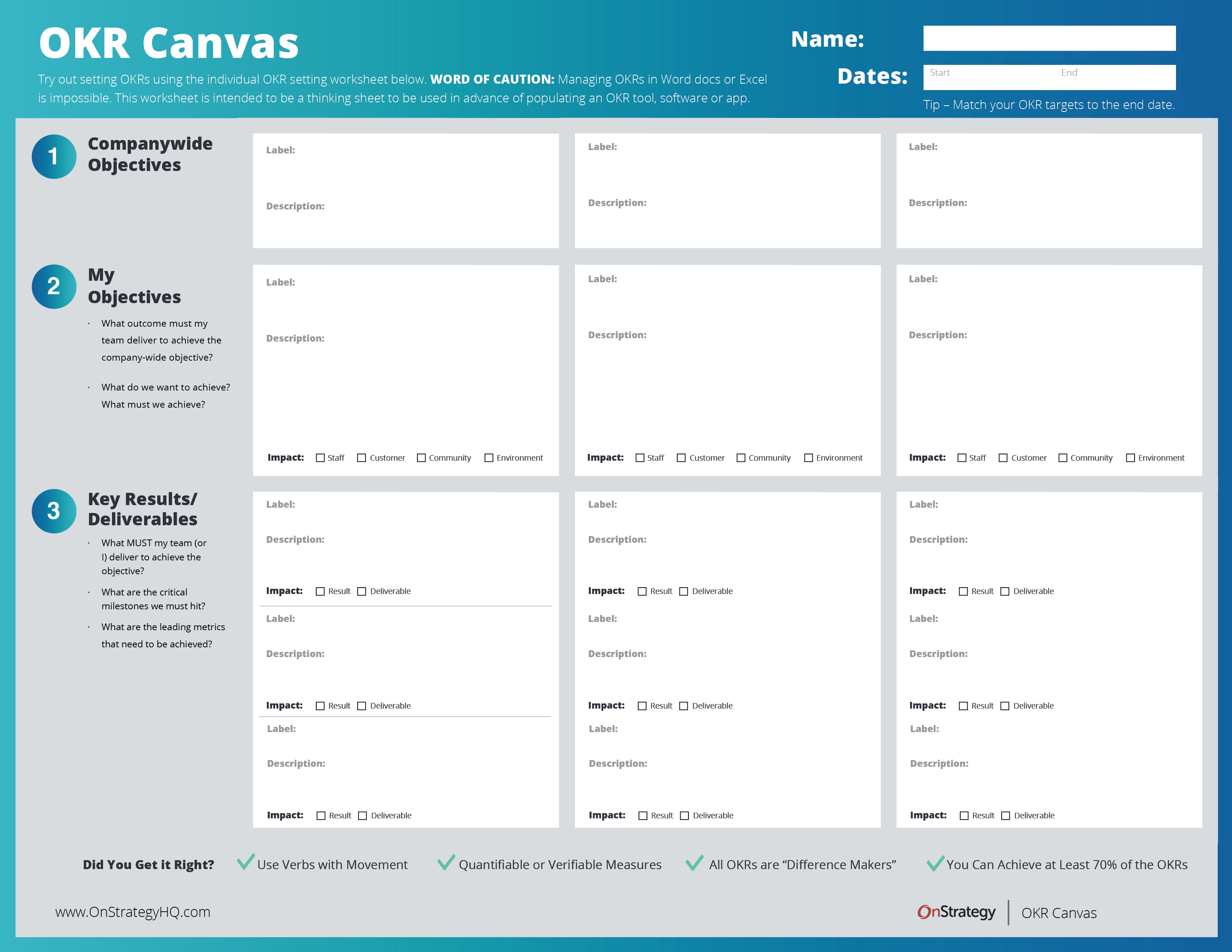In this 6-minute video, learn what OKRs (Objectives and Key Results) are and see if the OKR methodology is right for your organization.
Video Transcription
What is an OKR?
OKRs are a three-letter acronym for Objectives and Key Results. This particular thought process has been turned into a methodology popularized by Google for high-growth organizations to set goals and manage performance from the top of an organization all the way down to the individual level.
It’s really a great way to wrap in all kinds of ideas related to outcomes, accountability, commitments, agility, and the process of connecting individuals to the larger mission and vision of the organization. That’s what we love about OKRs!
Are OKRs Right for Your Team?
The OKR methodology has some inherent best practices and some tips really focused in driving tight alignment and commitment. That said, it might not be right for every organization, so let’s determine if it’s right for you.
OKRs are great for engaging your entire staff.
OKRs imply that you’re engaging all staff – and not all organizations engage all staff in the goal setting and performance management practices. If you are, it’s a great practice. If you’re not, you might listen a little bit critically.
OKRs are great if you have too many metrics.
If you’re an organization that has a ton of metrics, in fact, too many metrics to figure out what to focus on and what not to focus on, OKRs really help you dial into what matters most. So, if you have a lot of metrics that need focus, it’s a great methodology for you.
You must have a clear direction and vision for OKRs to work.
This is really important – you must a clear direction as an organization. There has to be a mission and a larger big old vision that OKRs align to and cascade from. If you don’t have a clear direction for your organization, you check out our videos on mission and vision!
A clear direction is required, otherwise, you just have an OKR puddle – a bunch of objectives and key results that don’t really work together and align the organization in a specific direction. Really, at the end of the day, goal setting and OKRs is about alignment of resources, talents, and energy in a singular direction.
The OKR methodology and cadence must fit with your team culturally.
And lastly, there needs to be a cultural fit. Even the words we’re using – key results – indicates and communicates commitment, accountability, performance, and rigor.
Sometimes, organizations and teams aren’t quite ready for that. Inherently, OKRs drive planning and performance reviews on a quarterly basis. It’s pretty agile. It’s not required to be quarterly, but that’s technically one of the core principals of this methodology. And that might not be the right fit for you!
Tips About OKRs You Can’t Miss
Here are few not-to-be-missed tip that you can use as a checklist for you as you’re building the OKR process in your organization.
You must have a direction.
I already talked about setting the direction first, just really emphasize that. You got to be aligned as an executive team on where you’re going and why.
SMART still applies.
SMART still applies. If you like the specific, measurable, actionable, realistic or responsible, and time-bound thought process, it’s embedded in the OKR methodology. Really, OKRs do incorporate a lot of best practices in goal setting – particularly the measurable, accountable and actionable.
The word “results” can be confusing.
The word “results” can be a little bit confusing. “Results” can feel too restrictive. So, when we think about results, think about quantifiable outcomes and verifiable outcomes like deliverables or initiatives. So, results can be “quant” metrics and deliverables.
Cascading is a bit different.
Cascading is a little bit different. So, we’ll talk about that in the upcoming whiteboard video, but here’s a little more depth in the cascade and also, there’s an opportunity to do some bottom-up planning. We’ll talk about the power of that.
Think quarterly.
We already talked about this, but OKRs are built on a quarterly process.
Don’t introduce new language.
If you have strong planning language in your organization today – be it goals, initiatives, action items, KPIs – there’s no magic in using the exact OKR words. This is just a methodology to make the planning process work a little bit better. Suspend the need to adopt the words specifically if you already have strong language in your organization.
Think about having a bigger impact.
And lastly, we want to introduce the idea that OKRs can really help you think about having a bigger impact. Results can have value to the organization, but they can also have value to your community, to your employees, to the environment. We like creating value corporation and that can really be embedded in the key results process.
Download the Free Guide for Setting OKRs that Work!
Get the free guide and canvas to learn how you can leverage the OKR (objective and key result) model for goal setting and accountability that was popularized by Google.













